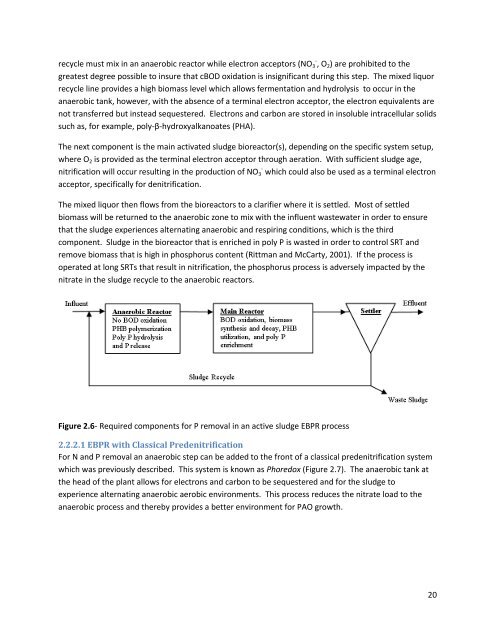E-Andrew Sindt Creative Component S11.pdf
E-Andrew Sindt Creative Component S11.pdf
E-Andrew Sindt Creative Component S11.pdf
You also want an ePaper? Increase the reach of your titles
YUMPU automatically turns print PDFs into web optimized ePapers that Google loves.
ecycle must mix in an anaerobic reactor while electron acceptors (NO 3 - , O 2 ) are prohibited to thegreatest degree possible to insure that cBOD oxidation is insignificant during this step. The mixed liquorrecycle line provides a high biomass level which allows fermentation and hydrolysis to occur in theanaerobic tank, however, with the absence of a terminal electron acceptor, the electron equivalents arenot transferred but instead sequestered. Electrons and carbon are stored in insoluble intracellular solidssuch as, for example, poly-β-hydroxyalkanoates (PHA).The next component is the main activated sludge bioreactor(s), depending on the specific system setup,where O 2 is provided as the terminal electron acceptor through aeration. With sufficient sludge age,nitrification will occur resulting in the production of NO 3 - which could also be used as a terminal electronacceptor, specifically for denitrification.The mixed liquor then flows from the bioreactors to a clarifier where it is settled. Most of settledbiomass will be returned to the anaerobic zone to mix with the influent wastewater in order to ensurethat the sludge experiences alternating anaerobic and respiring conditions, which is the thirdcomponent. Sludge in the bioreactor that is enriched in poly P is wasted in order to control SRT andremove biomass that is high in phosphorus content (Rittman and McCarty, 2001). If the process isoperated at long SRTs that result in nitrification, the phosphorus process is adversely impacted by thenitrate in the sludge recycle to the anaerobic reactors.Figure 2.6- Required components for P removal in an active sludge EBPR process2.2.2.1 EBPR with Classical PredenitrificationFor N and P removal an anaerobic step can be added to the front of a classical predenitrification systemwhich was previously described. This system is known as Phoredox (Figure 2.7). The anaerobic tank atthe head of the plant allows for electrons and carbon to be sequestered and for the sludge toexperience alternating anaerobic aerobic environments. This process reduces the nitrate load to theanaerobic process and thereby provides a better environment for PAO growth.20
















